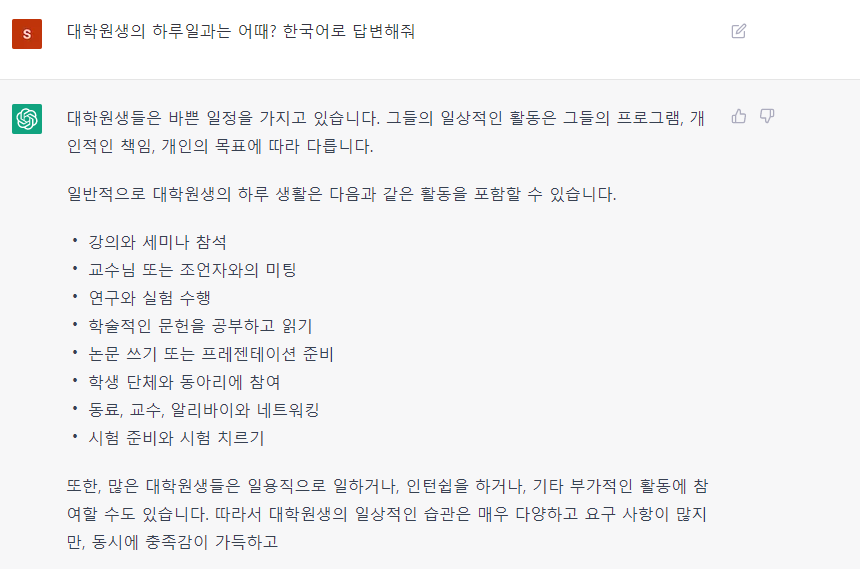어느 정도 만족할 만한 수준으로 대답해 주지만, 깊게 들어가는 상세한 내용은 정확도가 떨어지고 약간의 단어가 잘못 출력된다. 아직 완벽한 성능은 아닌 듯하다.
참고로 유료 서비스와 기존 사용자 간의 속도 차이가 생각보다 많이 난다. 코드 물어보면 출력 속도가 많이 느려서, 코딩하는 사람들은 유료 결제로 사용하는 것이 훨씬 나아 보인다.









Metagenome analysis is a complex process that involves multiple steps and tools. The following is a general outline of the typical steps involved in metagenome analysis and the tools commonly used in each step.
- Quality Control (QC) and Trimming: In this step, raw sequencing data is filtered to remove low-quality reads, adapter sequences, and other contaminants. Tools such as Trimmomatic, FastQC, and PRINSEQ are commonly used for quality control and trimming.
- Assembly: In this step, overlapping reads from the same microbial species are combined to create longer DNA sequences. De novo assembly tools such as SPAdes, Velvet, and SOAPdenovo are commonly used for metagenome assembly.
- Binning: In this step, assembled sequences are grouped into putative microbial species. Tools such as MaxBin, Concoct, and Metabat are commonly used for binning.
- Taxonomic classification: In this step, binned sequences are assigned to taxonomic groups using reference databases such as the NCBI taxonomy database, the Silva database, and the Greengenes database. Tools such as Kraken, CLARK, and MEGAN are commonly used for taxonomic classification.
- Functional Annotation: In this step, the functional potential of each binned sequence is determined by comparing it to reference databases such as the KEGG database, the COG database, and the Pfam database. Tools such as EggNOG, Blastp, and HMMER are commonly used for functional annotation.
- Statistical Analysis: In this step, the resulting metagenome data is analyzed statistically to determine the abundance and diversity of microbial species, functional pathways, and other features. Tools such as QIIME, Mothur, and STAMP are commonly used for statistical analysis of metagenomic data.
It's important to note that the specific steps and tools used in metagenome analysis can vary depending on the research question, the type of sample, and the availability of computational resources.
어느 정도 만족할 만한 수준으로 대답해 주지만, 깊게 들어가는 상세한 내용은 정확도가 떨어지고 약간의 단어가 잘못 출력된다. 아직 완벽한 성능은 아닌 듯하다.
참고로 유료 서비스와 기존 사용자 간의 속도 차이가 생각보다 많이 난다. 코드 물어보면 출력 속도가 많이 느려서, 코딩하는 사람들은 유료 결제로 사용하는 것이 훨씬 나아 보인다.









Metagenome analysis is a complex process that involves multiple steps and tools. The following is a general outline of the typical steps involved in metagenome analysis and the tools commonly used in each step.
- Quality Control (QC) and Trimming: In this step, raw sequencing data is filtered to remove low-quality reads, adapter sequences, and other contaminants. Tools such as Trimmomatic, FastQC, and PRINSEQ are commonly used for quality control and trimming.
- Assembly: In this step, overlapping reads from the same microbial species are combined to create longer DNA sequences. De novo assembly tools such as SPAdes, Velvet, and SOAPdenovo are commonly used for metagenome assembly.
- Binning: In this step, assembled sequences are grouped into putative microbial species. Tools such as MaxBin, Concoct, and Metabat are commonly used for binning.
- Taxonomic classification: In this step, binned sequences are assigned to taxonomic groups using reference databases such as the NCBI taxonomy database, the Silva database, and the Greengenes database. Tools such as Kraken, CLARK, and MEGAN are commonly used for taxonomic classification.
- Functional Annotation: In this step, the functional potential of each binned sequence is determined by comparing it to reference databases such as the KEGG database, the COG database, and the Pfam database. Tools such as EggNOG, Blastp, and HMMER are commonly used for functional annotation.
- Statistical Analysis: In this step, the resulting metagenome data is analyzed statistically to determine the abundance and diversity of microbial species, functional pathways, and other features. Tools such as QIIME, Mothur, and STAMP are commonly used for statistical analysis of metagenomic data.
It's important to note that the specific steps and tools used in metagenome analysis can vary depending on the research question, the type of sample, and the availability of computational resources.
